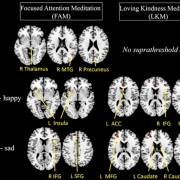Meditation on buddha forms improves visual spatial processing

The Buddha Form Chenrezig (Tibetan) or Loving Eyes
In Indo-Tibetan Vajrayana Buddhism (Engl.: Diamond Way), that was primarily practiced in Tibet and Himalayan countries like Bhutan and Nepal, meditating on buddha forms is a common practice. Often confusingly referred to as ‘deities’, These buddha forms are expressions of a well-functioning mind (see trust-based approaches to meditation) and calling such forms to mind as “forms of energy and light” plays an important role in formal meditation practice.
In a recent study carried out by researchers in the US, it was shown that meditating on buddha forms as the one seen on the right, enhances visuospatial processing efficiency. Compared to a group of meditators who engaged in a different form of meditation, called ‘open presence’, that involves a high levels of distributed attention without a particular object of attention, meditators who focused on an internally generated visual image of a buddha form, demonstrated a dramatic performance increase in a computerised mental imagery task they completed prior and directly after a meditation session.
- Do you meditate? Participate in our meditation research! - 2021-05-31
- Online Meditation and Mindfulness Conference - 2021-03-29
- Meditation Research Roundup 2021-01 - 2021-03-27








This is really interesting. Similar to other studies (mind life institute http://www.mindandlife.org etc) showing how different kinds of meditation can affect different cognitive functions due to brain plasticity. So not only can you be permanantly happier with regular meditation practice, your cognitive skills will improve too!
Hello Joy,
thanks for your comment. Indeed, a happier and more fulfilled life seems possible. When looked at from the perspective of psychological science the understanding would probably be that cognitive skills are one of the prerequisits for higher well being.
An interesting article by Alan Wallace and Shauna Shapiro (2006) pulls these ideas nicely together.
They are actually suggesting that we have to achieve a balance in four domains to be in a state of mental balance – leading to exceptional levels of well being. These are conation, attention, cognition and emotion.
Check it out here: doi: 10.1037/0003-066X.61.7.690 or directly to the pdf-file: pdf-download
And yes, quite a lot of the current meditation research has been inspired (sometimes even financially supported) by the mind and life institute 🙂
Peter